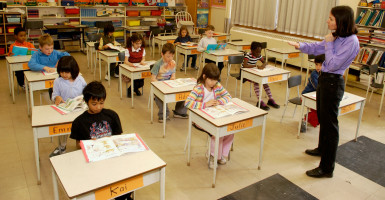The Obama administration responded to stacked complaints about excessive testing in schools, announcing new guidelines over the weekend that would scale back ballooned emphasis on standardized tests.
Though President Barack Obama said Saturday that the Department of Education would work “aggressively” with states and school districts to curb testing, his plan is expected to affect students only slightly.
Lindsey Burke, an expert in education at The Heritage Foundation, said that until the administration releases full guidance in January, the impact of its plan on schools cannot be entirely assessed, but she predicted that the guidelines will do “very little” to reduce excessive testing.
She pointed to “rigid” federal testing mandates along with the constraints of No Child Left Behind, which she said extended Washington’s role in setting testing schedules leading to the avalanche of standardized tests students are required to take.
“Much of the over-testing parents dislike will not be corrected, it seems, by this latest action on the part of the administration,” Burke said. “Unless Congress eliminates the annual testing mandate in No Child Left Behind, students will still be tested annually in grades three through eight and again in high school in the core subjects. And many states remain in Common Core, adding to the testing burden.”
Obama announced the plan in a video message posted to Facebook, vowing to work with school districts to ensure that students are taking only tests that supplement quality teaching and learning.
“Our kids should only take tests that are worth taking—tests that are high-quality, aimed at good instruction, and make sure everybody’s on track,” Obama said.
“Learning is about so much more than just filling in the right bubble.”
The Department of Education conceded that the administration is partly to blame for “unnecessary” testing, recommending in its “Testing Action Plan” that schools cap the amount of time students spend on taking exams to no more than 2 percent of classroom time.
The department also called on Congress to “reduce over-testing” after lawmakers voted last summer to reauthorize No Child Left Behind, the nation’s Bush-era education standards that poured a wave of federal programs and testing standards onto U.S. public schools.
Burke said the “most impactful” piece of the plan is that it limits “double-testing” for students in eighth grade who, for example, passed an advanced placement math test but then have to additionally take the ninth-grade state math test.
While the plan offers suggestions for school districts to follow, the guidelines are nonbinding.
The administration said it would issue detailed guidance in January advising states and districts on how to use federal money to assess the quality of their testing procedures. It will also provide advice on how schools can best use testing as an effective learning tool.
The administration’s announcement came the same day as a Council of the Great City Schools report that evaluated testing in the U.S.’s largest urban school districts.
The study found that the average student will take roughly 112 standardized tests before high school graduation—about eight per year. Those numbers exclude “optional tests, diagnostic tests for students with disabilities or English learners, school-developed or required tests, or teacher designed or developed tests.”
Notably, the study discovered “no correlation between time spent testing and improved math and reading scores.”
Union groups that have fought against mounting testing requirements and the use of test scores to assess teachers backed the administration’s plan.
“It’s a big deal that the president and the secretaries of education—both current and future—are saying that they get it and are pledging to address the fixation on testing in tangible ways,” Randi Weingarten, the president of the American Federation of Teachers, said in a statement.
Weingarten called the plan “common sense” but stipulated that “the devil is in the details.”

























